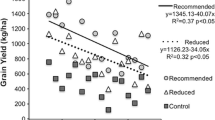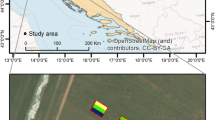Abstract
Soil productivity is positively related to soil pH. Animal manure is good alternative for improving soil pH over time. “Impacting” is a term used to refer to the establishment of mobile kraals in crop fields, creating a nutrient hot spot. This pilot study sought to assess the effect of impacting on soil improvement. The study was carried out at the research and learning plot of Lupane State University, Zimbabwe. A randomized complete block design with two treatments was used: Kraal and no Kraal treatments.Soil samples were collected before planting. Data were analysed using the unpaired t-test. The pH in kraal treated plots averaged 6.0, while that of the no-kraal plots, averaged 4.8. Impacting can improve soil pH in one season. More research is needed on the impact of kraal duration on soil compaction and its effect on crop growth and development.
Access provided by Autonomous University of Puebla. Download chapter PDF
Similar content being viewed by others
Keywords
Introduction
Soil productivity in most of African communal and smallholder crop fields continues to decrease. Soil productivity is positively related to soil pH (Mukungurutse et al. 2018). Soil pH is mostly influenced by soil parent material, percentage of sand and fertilizer application. In Lupane and most of Zimbabwe communal and smallholder farms, soils are predominantly sandy and are acidic (Shoko and Moyo 2011; Mukungurutse et al. 2018). In addition, over the years, the use of acidifying fertilizers has been mismatched with liming requirements (Nyamangara and Mpofu 1996). Acidic soils are less productive: Nutrients are not readily available and microbial activity in the soil is reduced (Mukungurutse et al. 2018). The combined effect of poor soils and changing climate patterns increases crop stress resulting in reduced productivity and sustainability of farming. Liming is required at above 500 kg/ha to improve soil productivity (Shoko and Moyo 2011). Liming products are not readily available to communal and smallholder farmers both affordability and availability. Animal manure is good alternative for improving soil pH over time (Whalen et al. 2000; Naramabuye et al. 2008). In communal areas, application of animal manure follows a gradient with the fields close to the homestead getting more manure than those further away from the homestead. The use of mobile night cattle kraals in crop fields (impacting), is a possible method of improving soil pH with accessible resources (Chinyere et al. 2015).
“Impacting” is a term used (by those implementing the technology) referring to a crop-livestock integration technology where mobile kraals are placed in crop fields and cattle spend several nights before the kraal is moved to a new location within the field. Both solid and liquid excreta from the cattle are left where the kraal was placed creating a nutrient hot spot.
Communal grazing of livestock in rural areas presents an opportunity to improve crop-livestock farming systems through impacting. Impacting has the potential to improve soil health in crop fields (Chinyere et al. 2015). The technology reduces labour needed to carry manure from permanent kraals into the crop field. Some farmers in Hwange, Zimbabwe and other parts of the country have started using the technology and are pleased with the improved yield in one season implementation (personal communication). There is need to understand the changes taking place when impacting crop fields. This study seeks to assess the effect of impacting on soil pH in crop fields.
Materials and Methods
The study was carried out at Lupane State University research plot in Lupane, Zimbabwe. The soils are predominantly Kalahari sands. A randomized complete block design with two treatments was used: Kraal and no Kraal treatments. In 2016/17 season, three kraal treatments were established and in 2017/2018 season, thirteen kraal treatments were achieved. For the kraal treatments, eighteen cattle spend the night in one kraal for 7–10 days, and then moved to the next plot. Each plot was 8 m by 8 m. Soil samples were collected before planting to a depth of 20 cm and sent for analysis. Each impacted plot had the kraal placed once during off-season. Data were analysed using the t-test in Numbers Version 3.1 (1769).
Results
Soil pH was significantly (P < 0.05) different between the kraal and no-kraal treated plots in both 2016/17 and 2017/18 seasons (Table 1). The pH in kraal treated plots averaged 6.0 for the two seasons while for the no-kraal plots, it averaged 4.8 (Table 1).
Discussion
Soil pH is a good indicator of how suitable a soil is for sustaining crop growth. Soil pH of 6.0–7.5 is considered best for most crops including maize. Without kraal treatment, pH was acidic at 4.8. Nitrogen, phosphorus, potassium, sulphur, calcium magnesium and molybdenum are largely unavailable when pH is below 5.5. Manganese, copper, zinc and boron are moderately available. Only iron is available in acidic soil. At pH of 6.0, nutrients are available or moderately available (United States Department of Agriculture Natural Resources Conservation Service [USDA-NCRS] 2014). Most communal and smallholder farmers do not lime their crop fields. Generally, input schemes avail seed and fertilizer to communal farmers without much consideration for soil pH. Therefore, the fertilizer, although applied, is still not available to the growing crop. Thus, a poor crop yield is obtained. One week of kraal treatment might have increased nutrient availability by correcting soil pH to 6.0 from 4.8 within the same season. Applying cattle manure improves soil pH (Whalen et al. 2000; Mtangadura et al. 2017; Chinyere et al. 2015) but it comes with increased labour requirements and also causes nutrient gradients when applying manure to crop fields.
Conclusion
The use of impacting technology can improve soil pH in one season and make nutrient available for plant uptake. Research on the impact of kraals in crop fields will continue. Focus will continue on soil nutrient changes, soil compaction issues and the growth and development of the growing crops.
References
Chinyere GC, Osuocha KU, Imo C (2015) Influence of Lokpa cattle market wastes on agricultural soil quality. Afr J Environ Sci Technol. https://doi.org/10.5897/ajest2014.1768
Mtangadura TJ, Mtambanengwe F, Nezomba H, Rurinda J, Mapfumo P (2017) Why organic resources and current fertilizer formulations in southern Africa cannot sustain maize productivity: evidence from a long-term experiment in Zimbabwe. PLoS ONE. https://doi.org/10.1371/journal.pone.0182840
Mukungurutse C, Nyapwere N, Manyanga A, Mhaka L (2018) Pedological characterization and classification of typical soils of Lupane District, Zimbabwe. Int J Plant Soil Sci. https://doi.org/10.9734/ijpss/2018/39609
Naramabuye FX, Haynes RJ, Modi AT (2008) Cattle manure and grass residues as liming materials in a semi-subsistence farming system. Agr Ecosyst Environ. https://doi.org/10.1016/j.agee.2007.08.005
Nyamangara J, Mpofu SE (1996) Soil PH and lime requirement for high potential communal areas of Zimbabwe. JASSA J Appl Sci Southern Africa. https://doi.org/10.4314/jassa.v2i2.16878.
Shoko MD, Moyo S (2011) Soil characterization in contrasting cropping systems under the fast track land reform programme in Zimbabwe. Afr J Food Agric Nutr Dev. https://doi.org/10.4314/ajfand.v11i3.66631
United States Department of Agriculture Natural Resources Conservation Service [USDA-NCRS] (2014) Soil health—guides for educators. Soil Health
Whalen JK, Chang C, Clayton GW, Carefoot JP (2000) Cattle manure amendments can increase the PH of acid soils. Soil Sci Soc Am J
Acknowledgements
I would like to thank Mr Roger Mudimba, Mr B. Sibanda and their farm assistants; and my colleagues Dr. F. Jomane and Mrs MT Moyo for assisting in establishingthe experiment.
Statement of Competing Interest
Funding was provided by Lupane State University Research Board.
Author information
Authors and Affiliations
Corresponding author
Editor information
Editors and Affiliations
Rights and permissions
Copyright information
© 2022 The Centre for Science and Technology of the Non-aligned and Other Developing Countries (NAM S&T Centre)
About this chapter
Cite this chapter
Nyamusamba, R.P.C. (2022). Impact of Mobile Night Kraals on Soil PH in Crop Fields—A Pilot Study. In: Poshiwa, X., Ravindra Chary, G. (eds) Climate Change Adaptations in Dryland Agriculture in Semi-Arid Areas. Springer, Singapore. https://doi.org/10.1007/978-981-16-7861-5_20
Download citation
DOI: https://doi.org/10.1007/978-981-16-7861-5_20
Published:
Publisher Name: Springer, Singapore
Print ISBN: 978-981-16-7860-8
Online ISBN: 978-981-16-7861-5
eBook Packages: Earth and Environmental ScienceEarth and Environmental Science (R0)




